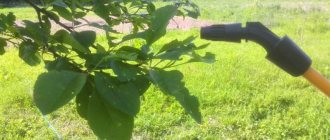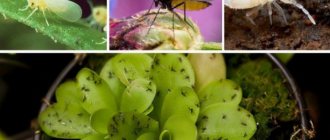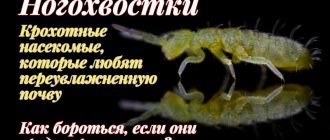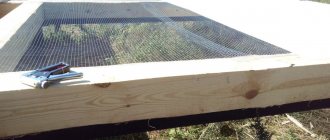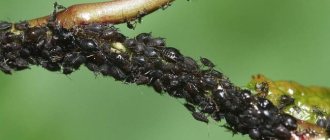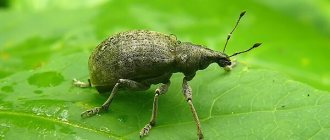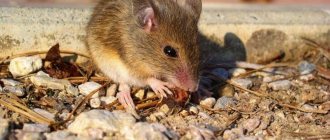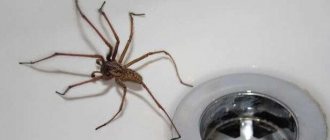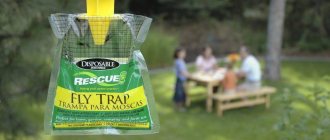Curling leaves, wilting buds, and the plant losing its attractiveness are the first signs of pests. To save the beauty on the windowsill, you need to know how to get rid of aphids on indoor flowers and prevent their appearance in the future. When fighting parasites, it is important to identify and eliminate the causes of the problem, and then destroy the pests using folk remedies or insecticides.
Aphids are a dangerous parasite that quickly adapts to any conditions and in a short time creates large colonies that destroy indoor plants. To save your home greenhouse, it is important to start pest control in a timely manner.
The article contains relevant and effective methods of combating aphids that will help save the plant and restore its attractiveness and vitality.
Description of aphids and how they appear in the house
Aphids are small insects with long legs and a pointed abdomen. The oblong body can be yellow, green, black or pink, but white pests are most often found on indoor plants.
One female aphid can lay up to 100 eggs at a time, which in a couple of weeks turn into adults that destroy flowers. Parasites use their proboscis to suck out the juice from the stems and leaves, depriving the plant of its vitality and attractiveness. In addition, they often spread viral and fungal diseases (sooty fungus). If the necessary measures are not taken in a timely manner, pests quickly adapt to any habitat and form numerous colonies that can destroy all the beauty on the windowsill.
Aphids attack different types of plants, but hyacinths, chrysanthemums, hibiscus, orchids, fuchsias and cyclamens are especially susceptible to attack by pests.
Where can pests appear in the house:
- through open windows and a balcony in the absence of mosquito nets;
- with new flowers (cut or in pots);
- from a person's clothing;
- through the soil used for transplantation;
- The carriers of the larvae can be ants that breed aphids for their own food.
To avoid the spread of aphids from a newly purchased plant to your home ones, keep it in quarantine for several days, and also carry out preventive treatment with special insecticides.
The main reason for the appearance of aphids is dried soil and high indoor temperatures.
House aphids - appearance and developmental features
Detecting this fragile, but dangerous and ruthless enemy is not difficult - aphids are clearly visible to the naked eye. Their usual sizes are from 0.5 to 2 mm. Winged females are larger, in some species they can reach 0.8 cm in length.
Aphids found on indoor flowers most often have a greenish or whitish color. But there are individuals colored dark - brown, or even reddish. The abdomen is swollen, visible in the sun, and often has two or several growths. Dark eyes and antennae are clearly visible. The legs of aphids are thin and translucent. Aphids cannot run and move slowly. Some types of aphids are capable of folding their legs in moments of danger and falling down to the ground.
Entomological classification of aphids
Currently, aphids, more precisely, True Aphids (lat. Aphidoidea), are included in the order Hemiptera (according to the outdated classification of aphids, they were classified as Homoptera). The order Hemiptera, or Proboscis, belongs to the phylum Arthropods, class Insects. Like all representatives of Proboscis, aphids have a piercing-sucking type of mouthparts. All types of aphids, without exception, are entomophagous and feed on plant juices.
Most often, ornamental plants are affected by the greenhouse aphid, also known as the house aphid, and less often by other insects from the family of grass aphids: peach aphid, nymphaean aphid, etc.
Attack of the Clones and Winged Mission
Aphids can reproduce asexually, which means they can actually clone themselves. The scientific name for this phenomenon is parthenogenesis.
But every few generations, a colony of aphids gives rise to a swarm of winged females, and with them, male aphids. The task of this generation is mating and the spread of aphid colonies to neighboring plants. A winged flock of fertilized females is carried by the wind far beyond the boundaries of the native population. There they look for plants suitable for feeding, and then go down to their roots and lay eggs for the winter. Clutches of parasites can be located both on the trunk of the host plant and in the soil, near its roots.
Population explosion as a way of resistance
The emergence of the winged generation of aphids can be provoked not only by the approach of autumn cold weather. Flying females appear at the moment when food begins to dry up. Or - if the colony is attacked by numerous enemies.
When attacked, for example, by lacewing larvae, aphids do not even try to escape. Although they have a clear advantage - the predatory larva is blind from birth, and searches for its prey at random, rushing from side to side. It is easy for sighted aphids to dodge its jaws, but... they continue to suck the juices of the plant, not paying attention to the danger. And the predator larva crawls along the leaf like a real killing machine, leaving behind only the empty skins of its victims.
But after some time, a real demographic explosion occurs in the devastated population. Each female produces four to five times as many aphid clones. Along with the wingless ones, winged individuals also appear, which fly around the surrounding area in search of quieter places. Aphids respond to danger with an explosive increase in numbers. This is her way of resistance.
Signs of pests on flowers
Aphids can cause significant damage to plants, so it is important to begin combating the parasites as early as possible. To do this, you need to know the signs of pests in your home greenhouse and periodically inspect each indoor flower for symptoms of disease.
The first manifestations of aphid infestation:
- a sticky layer and tiny punctures appear on the leaves and young shoots;
- flower buds quickly fade and fall off before they have time to bloom;
- the flower loses its attractiveness, withers and dries out;
- leaves darken and curl;
- Ants appear on the windowsill, attracted by the waste products of aphids, which are used by insects as food.
One of the signs of plant infestation by aphids is the appearance of ants. Insects feed on honeydew secreted by parasites, so they are always close to them and can even independently introduce pests to flowers
Signs of aphid damage to plants
Insects feed on the juice of tender parts of plants: they pierce leaves, buds, flowers with their proboscis and suck out the liquid.
Aphid colony under leaves
It is important to detect and remove aphids at the very beginning of colony development. When insects land on a new plant, they accumulate at the bottom of the leaf. When the colony grows, some of the pests move from the underside of the leaves to the front. More often, the owner of the flowers discovers the colony in this phase. To prevent the spread of aphids, starting in May, indoor plants are inspected. Pay attention to the condition of the leaves and shoots. When watering, you notice that there are small yellowish spots on the top of the leaf blade. These are traces of feeding by aphids, which pierce the delicate tissue of the leaf with their mouthparts and suck out the juice.
Stains
Deformations of plant tops
If you do not get rid of aphids in time, having colonized the leaves, the colony of insects spreads up and to the sides of the flower, finding new areas for feeding. Young succulent tissues are attractive to insects:
- stem growth points;
- tender parts of young shoots;
- young, newly formed buds.
Plants mistakenly overfed with nitrogenous fertilizers produce large, succulent shoots. Aphids strive for habitats where there is enough food. Shoots with a colony appear from a distance thickened, greenish-gray, as if covered with dust. After losing a significant part of the juice, the upper part of the plant becomes deformed. The new leaf blades that grow are small. Although they open, they have a curved shape, with many holes and punctures. Due to insufficient green mass, the plant develops poorly.
The buds are also deformed, do not open, droop, and fall off when there are a large number of insects. The opened flowers are ugly, full of holes, with brown spots.
Attention! If you notice insects on roses, or aphids appear on jasmine, think of something to treat as soon as possible.
White coating on leaves and shoots
After infection by aphids, the leaves lose their original appearance. In the course of their life, insects leave behind secretions in the form of a sticky coating. Dust gets on this surface, the shine disappears, the leaves look dirty and sloppy. With a large population, the leaf blade becomes deformed and curls. Sticky secretions clog the stomata of the leaves. Gradually the leaves dry out and fall off. The death of buds and young shoots also occurs.
Discharge
Unhealthy appearance of plants
Because of aphids, the flower becomes weak. Although at first only the leaves are affected by insect infestation of indoor plants, gradually, as the colony spreads higher and higher, onto the shoots, the diseased specimen loses its attractiveness:
- from the initial sign - yellowing dots, then plaque appears, the leaf curls and dries out;
- shoots have dark spots, are deformed, even after the colony has been destroyed, punctures and dry parts remain;
- the branches dry and bend;
- Very young plants with one or two growth points affected die.
If aphids appear on a domestic rose, how to fight it must be determined immediately. Insects spread pathogens of fungal and viral diseases on themselves, which often leads to the death of the plant.
Attention! Unhealthy appearance of plants, sticky coating and dirty leaves signal a possible insect infestation.
Folk remedies and methods of combating aphids
You can remove aphids from indoor plants yourself using available means. Such methods are easy to use, affordable and absolutely safe for healthy flora, people and pets.
Algorithm for saving indoor plants:
- Isolation of a sick flower, which will protect the rest from infection.
- Preventive spraying of healthy flora.
- Treatment of the affected flower using the chosen method.
Folk remedies for fighting aphids are presented in the table:
| Active substance | Procedure for preparing the composition | Mode of application |
| Celandine | Grind 150 g of dried raw materials or 350 g of fresh herbs and add 1 liter of water. Leave the product in the dark for 24 hours | Spray the plant with the resulting infusion three times at intervals of a day. |
| Wood ash | Mix 50 g of soap, 0.5 l of ash and 10 l of water | Treat the affected leaves and shoots with a filtered solution until the pests are completely destroyed. |
| Garlic | Grind 30 g of garlic in a blender, add 1 liter of water and leave to brew for a day in a dark place. | Treat the flowers with the resulting product three times at intervals of 5 days. |
| Tomato tops | Grind 500 g of raw material, add 1 liter of water and boil for 30 minutes. Add 4 g of liquid soap to the cooled broth | Treat the affected plant until complete recovery. |
| Tobacco | Combine raw materials and water in a 1:2 ratio and let it brew for 2 days. | Dilute the resulting infusion with water and spray the flower. Avoid contact with the soil to avoid damage to the root system. |
| Hot pepper | Grind 50 g of pepper and add 125 ml of water. Boil the mixture for an hour and let it brew for a day | Dilute the filtered infusion in 10 liters of water, use for spraying and watering flowers |
| Orange peels | Pour 100 g of citrus peel with water and let it brew for a couple of days in a warm place | Spray plants affected by aphids |
| Needles | Pour 500 g of pine needles into 2 liters of water and leave for a week, then strain and dilute with water in a ratio of 1:7 | Treat the flower several times with a break of 4 days |
Geranium, dill, parsley, mint or marigold will help fight aphids. Parasites cannot stand the aromas of these plants, so by placing a pot with one of them on the windowsill, you can not only get rid of pests, but also avoid their appearance in the future.
Ladybugs can be used as a biological method of controlling aphids, so do not drive out an insect that has settled on an indoor flower
Remedies for aphids on houseplants
Whitefly on indoor plants - how to deal with it at home
At the beginning of the fight against aphids, you can simply try to remove them mechanically. Inspect all leaves, buds and growing points, carefully collect insects using a soft brush or cloth. An effective method is to shower both affected and healthy plants, which is repeated periodically until the aphids completely disappear.
Spraying with plain water does not give much results; it is better to add laundry soap to the water. The solution is made in a ratio of 6:1. They also wipe all parts of the plant with a soft cloth moistened with soap and water, trying to capture all pests.
Spraying against aphids
Such mechanical methods can be used when there are few insects. The procedures are repeated regularly due to the fact that the larvae can be hidden in hard-to-reach places. As a last resort, the affected leaves are removed. There are many chemicals that can kill aphids. Insecticides are the only way to remove if black aphids appear on jasmine, chrysanthemums or cyclamen. Houseplants should be sprayed with pesticides:
- Drug 30 Plus;
- Fitoverm;
- Inta-Vir;
- Spark;
- Karate and others.
When using chemicals, make sure to ventilate the room. Some products emit an unpleasant odor. When using insecticides, remember that they are dangerous for children and animals, so they adhere to the following requirements:
- processing is carried out strictly according to the instructions;
- use gloves and a respirator;
- cover not only affected but also healthy plants.
After treatment, the condition of the flowers is checked. Usually, at first it is not possible to remove all the insects; larvae remain in hard-to-reach places and may reappear. Carry out 2-3 treatments with an interval of 7-10 days.
Additional Information . Spraying will be more effective when treating the substrate in a pot together, especially if white aphids have attacked.
Mechanical methods of getting rid of pests
You can save indoor flowers using mechanical cleaning, but this method is effective only at the initial stage of infection. To preserve the plant, remove damaged leaves, buds and shoots and wash it daily under running water. A solution of laundry soap will help to achieve maximum effect. Processing procedure:
- Prepare a soap solution from laundry soap and water in a ratio of 1:6.
- Prepare the necessary attributes, put on rubber gloves.
- Soak a sponge in the solution and thoroughly wipe all leaves, shoots and stems. Avoid getting the product on the soil.
- Rinse the plant with clean running water.
- Repeat the treatment daily until the parasites are completely eliminated.
To mechanically remove aphids, wipe the leaves daily with a damp sponge, remove affected shoots and bathe the flowers under running water.
As an alternative to soap solution, you can use medical alcohol - dissolve 6 tbsp in 1 liter of water. spoons of the product and wipe all the leaves. This composition effectively removes pests and does not damage the leaves, since ammonia quickly evaporates from the surface.
To be sure to get rid of aphids, replace the top part of the soil, where eggs and larvae of pests may be. In this case, choose high-quality soil that has been disinfected or frozen.
What does a pest like?
Aphids are polyphagous and harm almost all plants. She especially likes crops whose juice is rich in carbohydrates and amino acids. Aphids with delicate leaves, succulent shoots, and lush buds are often found. Which domestic flowers are affected by the pest:
- Violet;
- Orchid;
- Calla;
- Cyclamen;
- Begonia;
- Chrysanthemum;
- Hydrangea;
- Primrose;
- Hibiscus.
The palm family is rarely attacked by aphids due to the rigidity of the leaves and shoots.
Chemicals for killing parasites
If folk remedies are ineffective, use chemicals. The choice of means depends on the degree of damage and the scale of the disaster. The most effective means include: “Decis”, “Iskra”, “Fitoverm”, “Aktellik”, “Confidor”, “Akarin”, “Karate”.
Spraying flowers with chemicals will help get rid of aphids. When working with insecticides, observe safety precautions and strictly follow the instructions for the product.
Procedure for using chemicals:
- Read the instructions for use of the product.
- Take the recommended safety measures - put on seals and a respirator, remove pets and children from the premises. After handling, wash your hands thoroughly with a concentrated soap solution.
- Wipe the leaves and stems with a sponge soaked in soapy water and then let dry.
- Spray the flower. Carry out the treatment on the balcony on a cloudy day at a temperature of +21…25 ℃, since at a lower temperature the effectiveness of the drug decreases.
- Perform preventive spraying of all plants in the house to prevent aphids from moving onto them.
- Re-treat the flowers several times at intervals of 5-7 days (depending on the recommendations in the instructions).
If the plant cannot be saved, discard it to avoid contaminating other flowers.
Varieties
In total, there are about 30 species of aphids that live on indoor plants. In a large group, the most common varieties are:
- Home;
- Ordinary potato;
- Greenhouse;
- Apple green;
- Peach;
- Cabbage;
- Tobacco;
- Mealy;
- Bakhchevaya;
- Thistle;
- Cherry.
Aphids from garden crops prefer to settle on indoor flowers in the winter.
According to color it happens:
- White;
- Pink;
- Green;
- Yellow.
Reference! Black aphids can infect flowers with pathogenic bacteria and viruses. Lead to rapid death.
Popular: Reasons why monstera leaves turn yellow and what to do
Prevention of aphids
Proper plant care and compliance with the recommended preventive measures will help to avoid the appearance of aphids:
- periodically carry out preventive treatment of plants;
- Make sure to maintain the optimal temperature in the house, as insects settle in a stuffy, poorly ventilated room;
- keep new flowers in quarantine;
- install mosquito nets on all windows in the apartment;
- do not place bouquets of cut flowers (especially chrysanthemums and roses) near indoor plants;
- Soak the new soil for replanting in the cold for several days to destroy the larvae and eggs of pests.
To preserve indoor flowers, provide them with proper care, regularly inspect them to identify pests in a timely manner, and periodically carry out preventive treatment
Maintaining a favorable microclimate in the house, proper care of plants and compliance with preventive measures will help save indoor flowers from aphids. If you were unable to protect them from pests, start fighting when parasites are first detected, preventing the colony from growing. Mechanical treatment, folk remedies and chemicals can help in exterminating insects. The choice of control method depends on the scale of the disaster and individual preferences.
Life cycle
Pests multiply at high speed. One female produces up to 100 larvae. The transformation into an adult lasts two weeks. In one year, from 14 to 20 generations change. Wingless insects are needed for reproduction; winged insects fly to new plants. Coexist with ants.
At the same time in the colony you can find:
- Larvae of 4 instars;
- Nymphs of 2 instars;
- Wingless and winged females.
In the fall, females lay eggs, from which massive colonies of larvae emerge in the spring. After molting and maturing, individuals enter the stage of asexual reproduction. The number of wingless females can reach hundreds of thousands. Natural enemies are ladybugs and hoverflies.
Winged females migrate to new flowers. Over the course of a year, dozens of generations of wingless and winged individuals are replaced. With the onset of autumn, fertilization by male winged individuals occurs.
Biological methods
There is evidence that the smell of geranium repels aphids. For prevention purposes, you can take advantage of this feature and plant at least one bush of this flower in a pot. Among natural insecticides made from flower herbs, it is better to use, for example, Actofit. It protects and kills aphids thanks to the biological substance - aversectin C.
The drug is available as a liquid concentrate in bags and bottles. The treatment is carried out twice, with the second spraying performed after 2 weeks, when the larvae appear. Aphid eggs are immune to the insecticide.
How to keep plants safe
Taking into account the fact that aphids can get on plants in various ways - from trees outside the window to bouquets that can be affected by the pest, it is important to take timely precautions.
- Only purchased flowers in pots are quarantined separately for a week. If the pest has not manifested itself, then you can put the plant in a permanent place.
- It is better not to place gifted bouquets with plants on the windowsill, especially if they are roses or chrysanthemums. Ideally, it should be rinsed with water before placing it indoors.
- Potted crops should be bathed and inspected regularly.
- The house needs to be constantly ventilated, as aphids love hot, stuffy and humid places.
- You should start eliminating ants, which often bring aphids into the house.
These simple preventative measures will help eliminate the main factors in infecting indoor plants with aphids.
Causes
Why do aphids appear on plants? There are several infection options:
- Introduction of the pest with new flowers;
- Getting into household items, clothing, animal fur;
- Infection through freely moving insects;
- Transfer by ants from infected plants;
- Flights of winged pests;
- A drift with a soil mixture where the larvae are hiding.
To avoid infection, all newly purchased plants are kept in quarantine for 14 days. After the purchase, give the newcomer a warm shower with soapy water. The soil substrate for planting is kept in the freezer for up to 3 days.
Why are aphids dangerous for home flowers?
These insects pose a danger primarily to young plants with tender trunks and leaves. The female parasite lays eggs on the underside of the leaf. After the larvae hatch, they immediately begin sucking the sap from the plant. Deprived of nutrition and moisture, it sheds its buds, withers and dries up within a month.
Honeydew is also dangerous for flowers - the same “milk” secreted by aphids and so loved by ants. It promotes the appearance of sooty fungus, which eventually leads to the death of the plant.
